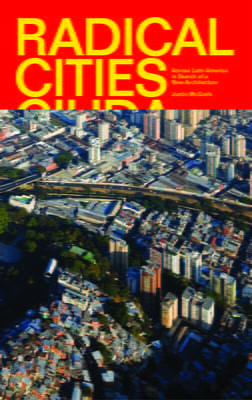A Review of Radical Cities: Across Latin America in Search of New Architecture
Transforming Cities through Architecture

Radical Cities: Across Latin America in Search of New Architecture By Justin McGuirk New York: Verso Books, 2014, 288 pages
Growing up in the midst of the Irvine Company’s unimaginative southern California, without exposure to anything other than strip malls and suburban tract homes, I was left with a perspective that sees architecture as a foreign concept reserved for big cities and museums. Seeing ugly buildings in a place bereft of architects filled me with a sense of disgust of/for buildings, and I would dream of ways to eliminate concrete from a specific geography back into grasslands.
I continued feeling this way when I repeatedly visited my birthplace in Mexico City and when I traveled to London, Paris and Rome in 1988 as a thirteen-year-old street surfer. I longed to be out of the dust of the Roman Coliseo and the rococo schmaltz of the French Versailles and I begged my parents to let me stay underwater in Elba. They were the first to try to get me to understand all the things that Justin McGuirk tells in Radical Cities about architects like Le Corbusier but it passed me by.
Even today, the thought of investing time and interest in established architects like Le Corbusier, or even Gaudí or Barragán, seems decades beyond what matters to me in an unequal society. This is, however, where Radical Cities begins to penetrate. McGuirk poses a circular dilemma: The corruption in the skybox in Latin America is such that it is impossible to maintain an egalitarian society at the street level where humans need housing. Under these corrupt systems, there aren’t any architects, or there aren’t enough resources for the few architects willing to build affordable housing for these individuals. So the people at the street level begin to create informal and scalable housing projects that then threaten the tranquility of the folks in the skybox.
McGuirk found several instances in Latin America where the circular dilemma was tested with creative thinking and cerebral resistance. The book is structured to simply flirt with the narratives of creativity and resistance and move on to the next instance. The first chapter begins to tell of Milagros Sala and the Túpac Amaru movement in northern Argentina, and the pattern set by McGuirk inspires the reader to imagine what might come next in Venezuela or Brazil or Mexico or Chile— all places suffering from mass inequality and classism but also benefiting from enormous fountains of creativity and its daughter, critical thinking.
The book gains in interest when the characters are as compelling as their acts of resistance. None is more inspiring than Milagros Sala, but next in line is the former mayor of Bogotá, Antanas Mockus. After the narrative failed to compel me in Chile, Brazil and Venezuela, McGuirk’s stop in Colombia brought me back to the pages. The dilemmas of the Colombian people and the solutions posed by Mayor Mockus are legendary. The time spent away from buildings and trams and spent on cultura ciudadana and Mockus’ “shared vision of the city” allows the reader to apply the principles learned in their own context without needing a degree in architecture or urban planning.
Upon completing the book, I posed a question to the author via email:
“Your book tends to compare and contrast opposites under the premise of: Who benefits? Most thinkers end up in the grey but the raw numbers always have the bourgeois political class benefiting over the folks on the street. I know that in Brazil, Argentina, Venezuela, Colombia and México, this is the case. Regardless of any activist architects making a move to attempt to balance the scale. Is this the same in a country like Norway where income equality is less obvious and the GDP PPP seems more balanced?”
I came to this question because early in my Latin American life I questioned why there was so much informality in Mexico. My parents would oftentimes joke that the answer was because there were Mexicans in Mexico. But upon rejection of that sarcastic answer, I would be told that Mexico, or Venezuela for that matter, is not Norway, or Sweden, and you can’t try to turn Mexico into Norway no matter how hard you try.
McGuirk wrote me back:
“Well, Norway is a very particular example. It’s the last of the extremely wealthy social democracies, with a small population and very limited poverty. It’s difficult to compare it to Venezuela, another oil-rich nation but with massive poverty. If I understand your question correctly I think the answer is ‘neoliberalism’. Neoliberal politics have been devastating to cities around the world, not just in Latin America. But the shift in Latin American cities to a laissez-faire, free market urbanism (coupled with mass urban migration) has resulted in the segregation of millions in the slums. I don’t think activist architects can affect this situation on their own. But I do think the case studies I document have valuable lessons in terms of how one can integrate and rehabilitate the informal city, and create a more equitable urban life. The key role of the activist architect for me is not just to propose design solutions but to be a conduit connecting government to disenfranchised communities. I don’t think urban equity can be achieved solely through bottom-up initiatives or top-down planning. I truly believe that citizens need to be involved and empowered, but their energy needs to be harnessed to government resources and strategic planning. Citizens can build their own housing but they cannot self-organize a transport network or a sanitation system.”
As intelligent as McGuirk is in his response, once having read about Milagros Sala and the Túpac Amaru movement in Radical Cities, I get the sense that while the formal city structure gets in the way of forward progress, the right approach to self- organization is found in their methods. So, I posed a follow-up question to McGuirk:
“Have there been any efforts to replicate the state within a state strategy of Milagros Sala and the Túpac Amaru movement?”
He replied,“Not that I know of. I mean it’s not really a state within a state, it’s just that their efforts at self-organization were so ambitious and comprehensive that they ended up providing services that traditionally the state would provide—healthcare, security, employment, charity etc. In a way it’s a testament to how disillusioned that community was with the local politics. One has to bear in mind that they also felt disenfranchised for ethnic as well as social reasons—i.e. being both Kolla Indian and poor. The reason it’s interesting to me is partly because of the scale of their achievements—community self-organization normally results in smaller initiatives like a community garden, not the creation of a whole fully functioning community. I think this comes down to them having an exceptional and charismatic leader. The other reason why it’s interesting is that it avoids property ownership and rising land values generally as a tool of social mobility. Across the world governments have been keen to sell off state-built social housing to give the poor more capital power (to make them better consumers in a sense) but this avoids that, empowering Túpac Amaru members through civic pride, employment, a sense of community etc. I’m not saying it’s perfect, but there’s a lot to learn from potentially. Should governments give communities more power instead of relying on the private sector to build housing? In my opinion, yes.”
There are moments in the book where you think the primary topic is architecture. Then, it moves to city-making. Then, it moves, rightly in my opinion, to the characters creating change within those cities. Whatever interests the reader most is relative, but in terms of format, the book begins with images of Tlatelolco and Buñuel’s Los Olvidados and ends with an architect named Teddy Cruz in a contract with Antanas Mockus looking out at Tijuana and San Ysidro while housed on the fourth floor of San Diego’s city hall. Two completely different visuals.
Radical Cities inspired me. Were I an editor at Verso Books, I would have reduced the case studies to the ones that were the most uplifting and detailed them for the calls-to-action of subjugated communities worldwide. But, like one of the characters in the book, I am “addicted to the taste of potential change.” Armed with this knowledge, where would I start? McGuirk poses a deep question arising from a character describing the Mexican- American border as the “Political Equator:” “Can the U.S., which has exported a pernicious neoliberal culture to the continent below it, gain something less destructive in return?”
Spring 2015, Volume XIV, Number 3
Sergio C. Muñoz is a Mexican artist working in the surf culture of southern California at Intelatin. His latest project is called Gamma Rae in the Americas. It is crafted for the benefit of DACA Dreamers in the USA. Twitter: @Intelatin
Related Articles
A Review of The Remarkable Reefs of Cuba: Hopeful Stories From the Ocean Doctor
It feels as though work takes up more and more of our lives, expanding into time it never used to touch.
A Review of Now We Are in Power: The Politics of a Passive Revolution in Twenty-First Century Bolivia
In Now We Are in Power, Angus McNelly provides an incisive examination of Bolivia’s complex political trajectory under Evo Morales, analyzing it through the lens of Antonio Gramsci’s seminal concept of “passive revolution.”
A Review of Roots of Resistance: A Story of Gender, Race, and Labor on the North Coast of Honduras
Once home to sprawling banana plantations under the control of U.S. multinationals, the history of the northern coast of Honduras is crucially bound with capitalist exploitation and extraction.




